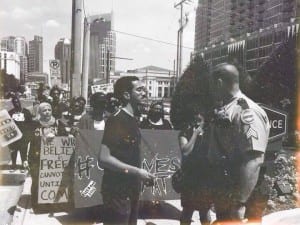Three years ago today, 17-year-old Trayvon Martin was fatally shot by George Zimmerman in Sanford, Florida. The circumstances surrounding the case led to a nationwide outcry for justice. Many were heartbroken as the controversial “stand your ground” law was used in Zimmerman’s defense, and Zimmerman was eventually acquitted of all charges.
Young people of color were faced with not only the tragic loss of someone who was just like them, but also with the reality that they were needed on the front lines of the struggle.
James Hayes, now 25, was in Chicago working with the social justice youth group Black Youth 100 the summer after Trayvon was shot when the not guilty verdict came down in the Zimmerman case.
“My generation came of age politically when Trayvon Martin was killed,” James said. “Folks were ready to move and building to move.”
James is an Ohio State University graduate who joined the staff of the Ohio Student Association (OSA) in August of 2012. He had helped to form the organization in January of the same year, just over a month before Trayvon was killed.
According to James, the tragedy sparked young folks to do more work. “I think it was the last straw for so many who held out hoping that the system would not betray us so blatantly,” James said.
He went on: “Since 2012, organizations have been linking up and building.” Organizations like Black Youth 100, Dream Defenders, United We Dream and others have been working in collaboration to build movement and power for youth of color.
Sadly, our country’s long history of police violence did not end with Trayvon. Following his tragic death was Wendell Allen, age 20; Rekia Boyd, age 22; Kendrec McDade, age 19; Ervin Jefferson, age 18; Kimani Gray, age 16; Andy Lopez, age 13—all young people of color, all unarmed and all killed at the hands of the police.
Then, on August 5, 2014, John Crawford III, a 22-year-old black man, was shot and killed by police officers in a Wal-Mart in James’ home state of Ohio. Police had received calls that there was someone in the store with a rifle, “waving it around.” The rifle turned out to be a pellet gun that had he had picked up off a shelf in the store.
Within a week, there were organized actions, vigils and demonstrations outside the Attorney General’s office who was managing the investigation. Among the community members active and looking for answers was OSA and its political director, James Hayes.

James is one of the growing number of young leaders that are fighting for change and challenging the profiling of youth of color. The fatal shooting of Mike Brown in Ferguson, MO on August 9, 2014 galvanized community members in Ferguson and activists across the country.
Organizations like Millennial Activists United and Young Activists United have been on the streets in Ferguson leading actions to challenge police brutality and change power dynamics in the city. James understands their fight and traveled to Ferguson for many weeks to offer support and help organize.
Following the non-indictment of the police officer who shot Mike Brown, James was among a select group of black and Latino organizers invited to the White House to speak to President Obama about the concerns of the movement and the loss of lives like Trayvon Martin’s, John Crawford’s, Mike Brown’s and so many more.
While the movement has gained new energy in recent years, James understands the work he’s doing within the context of a long struggle for justice. “Embedded in my work is what I have learned about the black freedom movement and the history of resistance in this country,” he said.
Following in the legacy of the 1964 Freedom Summer in which young people from across the country traveled to Mississippi to help register blacks to vote and to conduct Freedom Schools for people of all ages, social justice organizations led by young people of color have formed Freedom Side.
Freedom Side is a network of 69 young leaders of color, including James, who are stepping to the forefront of the fight for social justice and radical change. Adding their chapter to the history of freedom fighters in this country, these young leaders are building towards a better tomorrow.
Three years ago, young people of color across the country saw themselves in Trayvon Martin. They saw the fragility of a system that needs to be changed. They saw themselves under attack. From the tragedy of police violence emerged a powerful new vanguard dedicated to changing the system, empowering youth and collectively challenging marginalization and oppression.